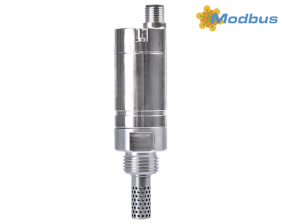
Industrial Oil Moisture Sensor AFO
Industrial Oil Moisture Sensor
Moisture Measurement in Technical Oils
Measuring range: 0 … 1 aw (activity of water)
Accuracy:
±0.02 aw at 23 °C (0 ... 0.9 aw)
±0.03 aw at 23 °C (0.9 ... 1 aw)
pmax: 300 bar
tmax: 125°C
Output: 2 x 4 ... 20 mA, RS-485, Modbus RTU-Protocol
Why is oil moisture measurement necessary?
The presence of water in oil can cause significant damage to machinery and components. Even with a water content only slightly above the oil saturation limit, the lifespan of components can be significantly reduced. Therefore, it is crucial to maintain the water content below the oil saturation limit.
Air humidity in the environment can absorb water, which is then dissolved in the oil until the oil saturation limit is reached. As long as this limit is not reached, the oil remains clear. With changes in operating temperature and reaching the saturation limit, this mixture can either lead to an emulsion (for example, when the oil's water separation capability is poor) or to free water (for example, when the oil's water separation capability is good). If the mixture forms an emulsion, the oil becomes cloudy. If the water is released, a two-phase oil-water mixture is present.
The oil saturation limit depends on various factors, including the operating temperature. Some oils can absorb more water than others. However, the water separation capability of oils decreases during operation, leading to the formation of water-oil emulsions. The oil circulation system should be designed to separate water as efficiently as possible.
The presence of water in oil can have various disadvantages and negative impacts:
Reduced Lubrication: Water in oil can impair the lubricating properties, leading to increased wear on machine components. This can result in premature wear of bearings, gears, and other moving parts.
Corrosion: Water promotes the corrosion of metallic components in machines and engines. Corrosion can cause structural damage and material failure, reducing the equipment's lifespan.
Oxidation: Water can accelerate the oxidation of oil, resulting in a decline in oil quality. Oxidized oil may lose its lubricity and overall performance.
Formation of Deposits: Water ingress can lead to the formation of deposits, especially in high-temperature areas. Deposits can compromise the efficiency of engines and hydraulic systems.
Reduction in Electrical Insulation Capability: In applications such as electricity generation, water in insulating oil can compromise electrical insulation, leading to short circuits or other electrical issues.
Deteriorated Filtration Performance: Water can negatively impact filter performance by promoting the formation of emulsions and causing filter clogging.
Bacteria and Fungus Growth: Water provides a breeding ground for bacteria and fungus growth. This can lead to biological contamination of the oil, causing additional issues.
Increased Operating Costs: The problems associated with water in oil, as mentioned, can result in heightened maintenance requirements, increased operating costs, and potentially downtime.
Therefore, monitoring and controlling the water content in oil are crucial for maintaining the performance and lifespan of machines and systems.
Are there exceptions, where water is desired in oil?
In certain industrial applications, the presence of water in oil may be desired, although these cases are specific and not the norm. Here are some examples where water in oil may be intentional:
Emulsion Formation in Metalworking: In metalworking, especially in machining processes, water can be intentionally used as an emulsifier. Water-oil emulsions can enhance cooling performance and reduce tool wear.
Hydraulic Fluids with Water Content: In specific hydraulic applications, hydraulic fluids may contain water to achieve specific properties such as improved pressure transmission or enhanced lubrication.
Cooling in Certain Transformers: In some electrical transformers, water is used as a coolant. However, this is a specialized application, and the amount of water is carefully controlled.
It's important to note that these cases are specific to certain applications and industries. In most industrial contexts, the presence of water in oil is undesirable.

Datasheet
Operating Instructions
Miscellaneous
Downloads
Description
The Moisture in Oil Transmitter model AFO with two analogue outputs for different measured variables and RS 485 Modbus interface as standard, enables reliable and long-term stable measurement in technical oils. Designed for measurements such as moisture content in transformer oil, motor oil, lubricating oil, hydraulic oil and diesel fuels. In addition to a highly accurate measurement of water activity (aw) as well as temperature (T), the AFO calculates the absolute water content (x) in PPM.
The moisture in oil can be measured and expressed in two different ways: as an absolute value or as a relative value.
• The relative moisture is expressed by water activity (aw). Water activity is a relative measure of moisture in oil and describes the ratio between the actual amount of dissolved water in the oil and the maximum amount possible at a given temperature. An aw value of 0 means that there is no water in the oil, while an aw value of 1 indicates complete saturation. Water activity is independent of the type of oil.
• The absolute moisture content is called water content (x) and expresses the actual amount of water in the oil, whether it is dissolved, emulsified or separated. Water content is measured in units such as ppm (parts per million) or mg of water per kg of oil and is independent of oil temperature. To assess the degree of saturation of the oil, the water content x must be considered in conjunction with the temperature (T).
The calculation of the water content x from the measured values for aw and T is oil-specific and requires special parameters for the respective oil. KOBOLD offers the possibility to adapt these oil specific parameters for different oil types. The required parameters can either be specified when ordering the AFO or subsequently integrated in the AFO using the Service software.






